2023 年 64 巻 8 号 p. 2006-2013
2023 年 64 巻 8 号 p. 2006-2013
The eight papers were selected for the best paper award in 2021 to 2022 from Materials Transactions. Here, the awarded papers are briefly summarized as current trends in research of Materials Transactions. Among the eight best papers, four were specially selected for young scientists whose ages are 35 or below. An important trend in the year of 2021 is that three best papers are from a special issue with the title of “Materials Science on Hypermaterials”, which is based on an ongoing national research project, Grant-in-Aid for Scientific Research on Innovative Areas.
We are pleased to announce the best papers awarded in 2022 by Materials Transactions. The eight papers were selected for this awards from the publications made in February 2021 to March 2022. Here, we introduce the eight awarded papers1–8) and this is our third opportunity for the introduction of the best papers following the first and second announcements made in 20209) and 2021.10) All the awarded papers are based on cutting edge research fulfilling one or more of the following requirements: (a) sufficient originality, (b) highly influential (good potential for significant research advancement), (c) solving long-term problem, and (d) being far ahead of others. The selection committees for the award carefully evaluated the papers recommended by referees of reviewing processes, editorial members of Materials Transactions and board members of the Japan Institute of Metals and Materials. Papers by authors’ self-recommendation were also accepted for the evaluation. Each paper was scored by about 10 members of a selection committee representing either of the following six research areas: (1) materials physics, (2) microstructures of materials, (3) mechanics of materials, (4) materials chemistry, (5) materials processing, and (6) engineering materials and their applications. The paper which earned the highest score won the best paper award in each of the corresponding research areas. However, if the score is low (below 3.5 out of 5), the paper is not qualified for the award even if the rank is the highest. In this year, three out of the eight best papers are for young scientists under age of 35 with the evaluation criteria of (a) and (b). In particular, this young scientist award is intended to encourage their future research activity. The eight awarded papers1–8) are introduced below with brief summaries provided by the corresponding authors.
Time-resolved observation on a scale of ns (10−9 s) to ms (10−3 s) has been available under various conditions (ex. at high temperatures, under gas atmosphere, and under mechanical shock) due to the recent development of time-resolved analytical methods using synchrotron radiation.11) The time range of ns (10−9 s) to ms (10−3 s) includes a various types of important phenomena in metallurgy and related areas such as chemical reactions,12) deformation,13) fracture,14) phase transitions, and so on. Here, the authors developed an analytical technique for time-resolved observation of the phase transformation of an Fe–C system during cooling via X-ray absorption spectroscopy with a time resolution of 200 µs. The kinetics of phase transformation in the Fe–C system during cooling are of great importance for controlling its microstructure and mechanical properties. However, real-time observation of the phase transformation has been a challenging task because of experimental difficulties. The developed technique was applied to model specimens: Fe, Fe–0.044C, and Fe–1.24C. The incubation time before phase transformation and the multiple steps of phase transformation from γ-Fe to α-Fe (+ Fe3C) could be clearly observed by the proposed technique, and the behaviors were significantly different among the specimens (Fig. 1). Through the developed technique, change in atomic structures at a short-range scale was detected, which is complementary to X-ray diffraction that detects atomic structures only in long-range order. The developed technique can detect structure changes at early stage of phase transformations, where structures changes often begin at a short-range scale, and provide inevitable information on the kinetics. For future perspectives, the time-resolved observation techniques will be combined with X-ray microscopy, where the “trigger sites” of chemical reactions15) and fracture16,17) can be investigated with a spatial resolution as small as 50 nm. Time- and spatial-resolved observations will provide us indispensable information on one of the most fundamental questions: when and where a reaction initiates and propagates.

Time-evolution of phase fractions of fcc (close circles) and bcc (open squares) phases determined by curve fitting of each XAFS spectra at each time t: (a) S-FeC2, (b) S-FeC1, and (c) S-Fe. Co-existence of phases are indicated by colored highlights; (a) (pink) γ-Fe(C) + Fe3C, (yellow) γ-Fe(C) + α-Fe(C) + Fe3C, and (blue) α-Fe(C) + Fe3C, (b) (pink) γ-Fe(C) + α-Fe(C), (yellow) α-Fe(C) + γ-Fe(C), and (blue) α-Fe(C) + Fe3C, (c) (green) γ-Fe + α-Fe. Note that the time range in (b) is different from the rest because the incubation period of S-FeC1 is larger than those of S-Fe and S-FeC1.
High-order periodic approximants (APs) (with >500 atoms per unit cell) to face-centered icosahedral quasicrystals in Al–Pd–TM (TM = transition metal) systems mimic the quasicrystals not only structurally but also in their physical properties. Their complex crystal structure can be deconvoluted into two distinct kinds of atomic cluster arranged according to a tiling architecture composed of four polyhedral cells, called the canonical cells.18,19) Here, the clusters are packed nicely such that all the atomic sites in the structure are accounted for by the cluster shells, while their centers are located at the vertices of the canonical cell tiling (CCT). In this paper,2) the authors put forward a unified geometrical framework to describe a variety of cluster arrangements in related icosahedral alloys by generalizing the tiling-based geometry. They show that in general hundreds or even thousands of atomic positions in the unit cell of an AP can be classified into fifteen kinds of decoration orbits associated with vertices, edges, faces, and cells of the relevant CCT. A significant correlation between these decoration orbits and chemical species that reside in them is revealed upon inspection of the refined crystal structure of the high-order AP in the Al–Pd–Cr–Fe system (with a structure type shown in the first row of Fig. 2(a)). This gives new insights into the crystal chemistry of related compounds in view of how different choices of the third transition-metal would affect the formation of these compounds. The authors also demonstrate the use of the present framework to investigate the unknown structure of a novel AP in the Al–Pd–Mo–Fe system. Here, a rational guess of the atomic jungle is made by postulating an underlying CCT (shown in the second row of Fig. 2(a)) to reproduce minute features in high-resolution powder XRD patterns obtained using synchrotron radiation (see Fig. 2(b)).
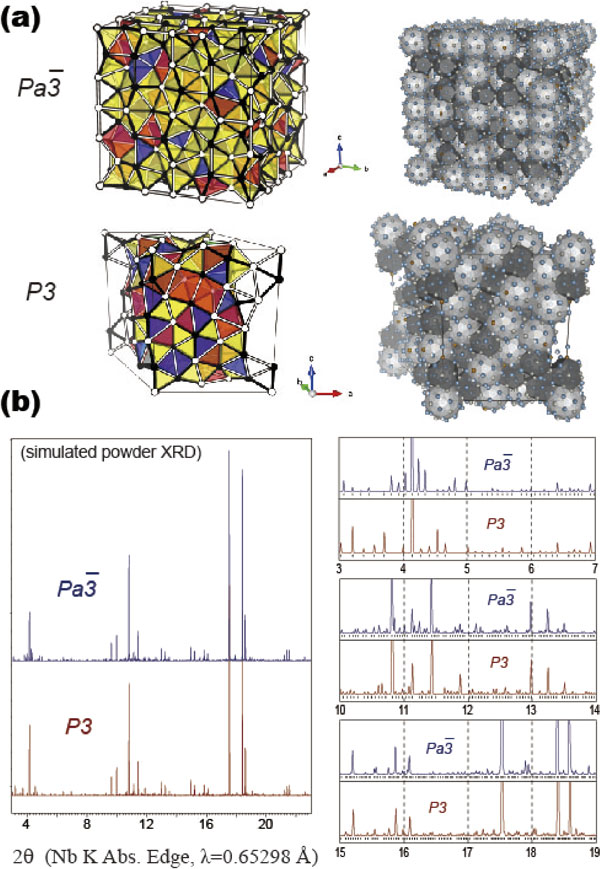
(a) Two CCTs and their corresponding atomistic structure models obtained using the decoration scheme.2) The first row represents the (2 × 2 × 2) cubic 3/2 AP.18) The second row represents a hypothetical trigonal superstructure of the 3/2 AP that is used to model a novel AP in the Al–Pd–Mo–Fe system. (b) Powder XRD patterns of the two structure models calculated using JANA200620) with a wavelength of λ = 0.65298 Å. Magnified plots shown on the right reveal minute differences between the two structures.
Tsai-type quasicrystals are alloys consisting of icosahedral clusters, indicating the five-fold rotational symmetry, which is prohibited in conventional crystals.21) Instead of the five-fold rotational symmetry, the translational symmetry is broken in the quasicrystals, while there is still a distinct long-range order unlike amorphous materials. Recent experimental studies discovered ferromagnetism in the quasicrystals,22) and various magnetism, e.g., ferromagnetism, anti-ferromagnetism, and spin glass-like magnetism, in the quasicrystal approximants,23–27) which are crystals composed of the common local structure to the quasicrystals. In these materials, magnetic moments of rare-earth ions located on icosahedral vertices dominate their magnetism, and are coupled with each other via the so-called Ruderman-Kittel-Kasuya-Yosida interaction.28,29) Here the authors theoretically investigate classical and quantum magnetic states on an icosahedral cluster within the Heisenberg interactions of all bonds. Simulated annealing and numerical diagonalization are performed to obtain the classical and quantum ground states. By means of these numerical calculations, the authors show qualitative correspondence of classical and quantum phase diagrams, where five different spin configurations appear (see Fig. 3 for classical version).3) This study gives a good starting point to understand the various magnetism in not only quasicrystal approximants but also quasicrystals.
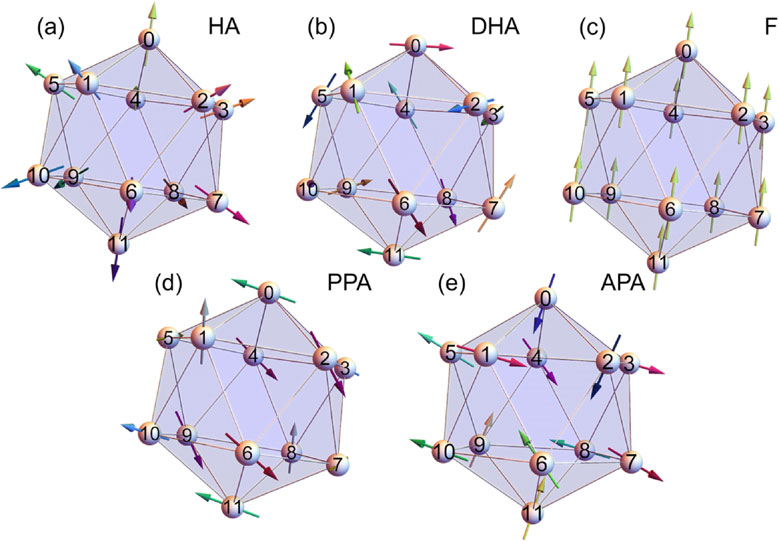
(a)–(d) Examples of ground-state spin configuration in hedgehog antiferromagnetic (HA), dual hedgehog antiferromagnetic (DHA), ferromagnetic (F), parallel pairs’ antiferromagnetic (PPA) phase. (e) Spin configuration of antiparallel pairs’ antiferromagnetic (APA) state appearing at the boundary of the HA and DHA phases.
The importance of controlling grain boundary (GB) segregation is increasing, particularly with the strengthening of steel. Therefore, the amount of GB segregation of a solute element with respect to its content and heat treatment temperature is essential basic data in material design. However, as experimentally investigating this data is time-consuming, the experimental data exists only for some elements.31)
The segregation energy calculated with the first-principles calculation using a symmetric tilt GB reproduces the magnitude relationship of the segregation energy of solute elements in polycrystals.32–38) In addition, first-principles calculations have been useful for elucidating GB segregation mechanisms33,39,40) and embrittlement.4,36,41–47) However, the segregation energy obtained by the calculation for the specific GB and amount of segregation calculated from it have been noted to quantitatively differ from the experimental values in polycrystalline GBs.48)
Therefore, the authors developed a method for predicting the amount of GB segregation for a solute element in polycrystals.49,50) Using this method and the fact that the atomic structure of GBs is almost independent of the grain size, the GBs of polycrystals with grain sizes of the order of micrometers are modeled as GBs of nano-polycrystals. For this GB model, the GB segregation energy of each site is exhaustively calculated using interatomic potentials. In addition, the average amount of GB segregation in the polycrystal is calculated from the obtained GB segregation energy.
In this study, the authors applied this method to the GB segregation of Mn and Cr in bcc-Fe polycrystals using the procedure illustrated in Fig. 4 and verified its validity.4,30) This method was determined to accurately predict the GB segregation energy of Mn and Cr in bcc-Fe polycrystals.

Overview of the prediction method for grain boundary (GB) segregation using the nano-polycrystalline GB model.
More than 80 different types of thermodynamically stable quasicrystals (QCs) have been identified so far.51) However, all of them are metallic, and no semiconducting or insulating QCs have been found. The search for semiconducting QCs is not only one of the challenging problems in solid-state physics, but also has great potential for application to high performance thermoelectric materials.52) Search for high-order semiconducting quasicrystalline approximants that have similar structure to quasicrystal can play an essential role in finding clues to the discovery of semiconducting quasicrystals. According to the previous theoretical work, a model of Al–Pd–Co 1/1 cubic quasicrystalline approximant was predicted to be semiconductor from a calculation based on the density functional theory. The authors noticed that the F phase in the Al–Pd–Co system is a 2 × 2 × 2 superlattice structure of the calculated model. To verify this prediction, they synthesized the F phase sample, and measured its thermoelectric properties. The measured electrical conductivity linearly increases with increasing temperature. The magnitude of measured Seebeck coefficient is smaller than the typical semiconductor. These properties indicate that the prepared sample of the F phase has a pseudogap rather than a finite band gap. To investigate this discrepancy between the theoretical prediction and experimental results, the authors calculated the electronic structure for the three structural models using density functional theory. While previous model shows semiconducting band structure as shown in Fig. 5, the most energetically stable model has a semimetallic electronic structure. The authors also calculated Seebeck coefficient for each model by using Boltzman transport equation with constant diffusion constant approximation,53) which is good approximation for complex structure alloy.54)
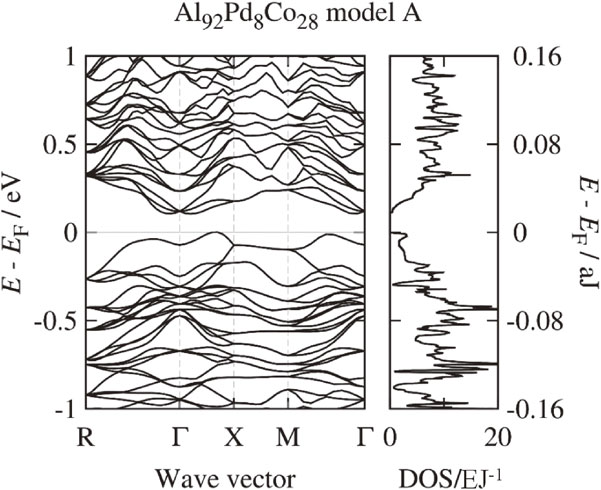
The electronic band structure (left) and density of states per cell DOS (right) around the Fermi energy EF of Al92Pd8Co28 model A.
Silicon single crystals were deformed in tensile tests along the $[\bar{1}34]$ direction between 1173 K and 1373 K. The yield point phenomenon was observed in the specimens deformed below 1273 K, while a continuous yield was observed in the specimens deformed above 1323 K. The values of work-hardening rate in stage II were the same as those reported in other single crystals.55,56) Orientation maps of the specimen obtained by using electron backscattered electron diffraction method indicated that stage II starts before the Schmid factor of the secondary slip system became larger than that of the primary slip system. Because of the constraint due to the gripping of the test piece, kink bands are formed during stage I before the onset of stage II, and then the stress state becomes non-uniaxial (Fig. 6(a)–(d)).57–59) This suggests that the formation of kink bands triggers the activation of the secondary, i.e., conjugate slip system to increase the resolved shear stress on the conjugate slip systems.60–62)

(a) Optical micrographs of the gauge sections (b) Color map using the plots in the inverse pole figure in (c). Arrows indicate kink boundaries. (c) Inverse pole figure with respect to A2. (d) Point-to-origin misorientation measured along a line in fig. (b). (e) Schematic of a dislocation array at kink boundaries.
Intermetallic particles (IMPs) in aluminum alloys enhance their mechanical properties,63–67) but some IMPs can be initiation sites for pitting.68,69) Chromate is one of the successful species for conversion treatments owing to its self-healing ability: the oxide/hydroxide film is reformed spontaneously when the film is damaged,70,71) preventing pitting over the long term. Since the use of chromate is restricted due to the toxicity of hexavalent chromium, chromate-free conversion treatments have been studied last few decades.72–74) However, in many cases, the thin film formed by the chromate-free treatments does not keep its inhibitive effects compared to the chromate treatments. Thus, the authors attempted to improve the pitting corrosion resistance of AA1050 by removing the IMPs from the Al-matrix during conversion treatments.
The open circuit potential (OCP) of AA1050 was measured in 10 mM CrO3 (blue curve in Fig. 7). The Al-matrix around the IMPs was locally dissolved with the decrease in OCP, and the IMPs, which become the pit initiation sites, were removed from the specimen surface. Pre-immersion in 1 M NaOH accelerated the dissolution of the Al-matrix around the IMPs in 10 mM CrO3 (red curve in Fig. 7). The removal of the IMPs during chromate treatment improved the pitting corrosion resistance of AA1050 in NaCl solutions. Furthermore, the pitting corrosion resistance provided by molybdate treatment was also improved by pre-immersion in NaOH. The maximum pit depth of AA1050 treated in MoO3–HNO3 solution after pre-immersion in NaOH was smaller than that of the chromate-treated specimen. The pitting corrosion resistance of AA1050 was as follows: (high) MoO3–HNO3 treatment with NaOH pre-immersion > chromate treatment with NaOH pre-immersion > MoO3–HNO3 treatment without NaOH pre-immersion > non-treated (low). The authors concluded that immersion in an acidic solution containing an inhibitor with NaOH pre-immersion is an effective approach to improve the pitting corrosion resistance of aluminum alloys.
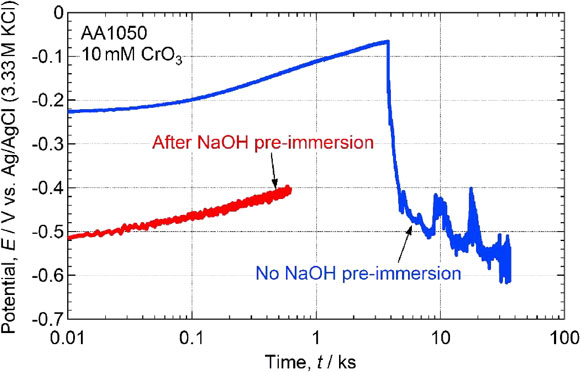
Time variations of the OCPs of AA1050 in 10 mM CrO3. The blue line indicates the OCP of the non-treated (as-polished) AA1050, and the red line indicates the OCP of AA1050 after pre-immersion in NaOH for 1 min (NaOH pre-immersion).
Magnesium alloys are the lightest of structural metallic materials. These alloys are increasingly used in automotive and aerospace industries, where they are instrumental in increasing fuel efficiency and thus minimizing carbon dioxide emissions.76) Another method for improving the high-temperature strength by using intermetallic phases is to control the microstructure so that the matrix and intermetallic phases are layered via a eutectic reaction.77–80) When a binary Mg–Ca hypoeutectic alloy with a composition close to the eutectic composition (Mg–16.2 mass% Ca) is melted and then cast with a mild steel mold, the resultant α-Mg/C14–Mg2Ca eutectic structure has a lamellar structure with a curved α/C14 interface.81,82) In tensile tests, α-Mg/C14–Mg2Ca eutectic alloy with a lamellar structure is plastically deformed above 473 K but ruptures before yielding at temperatures below 423 K. The effect of the α/C14 interface on the creep strength of α-Mg/C14–Mg2Ca eutectic alloy is investigated at 473 K under 40 MPa stress. The minimum creep rate is proportional to the lamellar spacing, indicating that the α/C14 lamellar interface plays a creep-strengthening role. In the high-resolution transmission electron microscopy images captured of the specimens after the creep test, dislocations are mainly seen within the soft α-Mg lamellae, and most of them are a-dislocations with an identical Burgers vector. The dislocations are not arranged, but randomly distributed at the α/C14 interface (Fig. 8). In contrast, dislocations are rarely introduced in the hard C14–Mg2Ca lamellae, and the dissociation reaction from a perfect dislocation to two partial dislocations by the following reaction is detected in the C14–Mg2Ca lamellae during creep; $1/3[11\bar{2}0] \to 1/3[10\bar{1}0] + \text{SF}_{(0001)} + 1/3[01\bar{1}0]$. It is deduced that the α/C14 interface presents a barrier to dislocation glide within the α-Mg lamellae and does not annihilate and/or rearrange the dislocations.
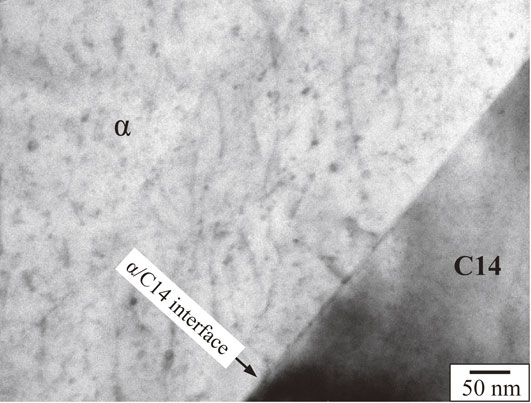
HRTEM image, taken with $\mathbf{B} = [01\bar{1}1]_{\alpha }$, of the α/C14 lamellar interface for the 723 K/1 h-aged α-Mg/C14–Mg2Ca eutectic alloy crept at 473 K under a stress of 40 MPa, where the creep test was interrupted at a strain of 1.3%.
First, it should be noted that the papers by Ito et al.4) and by Oishi et al.8) were originally published in Japanese in Journal of the Japan Institute of Metals and Materials.30,75) They were translated to English following the rule of Materials Transactions. Comments should be added to the two papers that Dr. Kazuma Ito, the first author of the former paper,4) is also a winner of the best paper award following from the last year.49) His two papers are concerned with the study on grain boundary segregation using nano-polycrystalline grain boundary mode. This consecutive awards were extoled so that the research was active to publish high quality papers. Furthermore, we find that a coauthor of the latter paper,8) Prof. Yoshihiro Terada, also received a Young Scientist Best Paper Award in 2021 as a coauthor.81) The subject common to both papers is microstructural analysis and creep deformation of α-Mg/C14–Mg2Ca alloy, and the two consecutive awards demonstrates that the study was well performed under the supervisor’s firm orientation towards publications of the high quality papers by young scientists.
Second, it should be noted that three out of the eight awarded papers are selected from the special issue (Vol. 62, No. 3) edited by Prof. Ryuji Tamura of Tokyo University of Science with the title of “Materials Science on Hypermaterials”.83) In fact, this special issue included the articles based on the latest results of a national research project,2,3,5,23,84–92) Grant-in-Aid for Scientific Research on Innovative Areas “Hypermaterials: Innovation of materials science in hyper space”. Readers will find their research outcome in the website and the summary of the special issue will be published in the near future from Materials Transactions.
In association with the awarded papers introduced above, popular topics that Materials Transactions published in recent years are grain boundary segregation93) as Ito et al. were concerned with,4,30,49) creep deformation in a wide range of materials94–102) including tricrystals by Okada et al.103,104) and work hardening in various forms of deformation in an aluminum single crystal,105) an A3104 aluminum alloy,106) a Ti–6Al–4V alloy107) and high-strength steels.108) Furthermore, pitting corrosion resistance is also a popular issue reported by many research groups in terms of corrosion behavior of pure aluminum,109) pure zirconium110) and stainless steels.111–113) Readers who are interested in such topics may be worth checking them.